Learning Objectives
- Calculate the derivative of an inverse function.
- Recognize the derivatives of the standard inverse trigonometric functions.
In this section we explore the relationship between the derivative of a function and the derivative of its inverse. For functions whose derivatives we already know, we can use this relationship to find derivatives of inverses without having to use the limit definition of the derivative. In particular, we will apply the formula for derivatives of inverse functions to trigonometric functions. This formula may also be used to extend the power rule to rational exponents.
The Derivative of an Inverse Function
We begin by considering a function and its inverse. If [latex]f(x)[/latex] is both invertible and differentiable, it seems reasonable that the inverse of [latex]f(x)[/latex] is also differentiable. (Figure) shows the relationship between a function [latex]f(x)[/latex] and its inverse [latex]f^{-1}(x)[/latex]. Look at the point [latex](a,f^{-1}(a))[/latex] on the graph of [latex]f^{-1}(x)[/latex] having a tangent line with a slope of [latex](f^{-1})^{\prime}(a)=\frac{p}{q}[/latex]. This point corresponds to a point [latex](f^{-1}(a),a)[/latex] on the graph of [latex]f(x)[/latex] having a tangent line with a slope of [latex]f^{\prime}(f^{-1}(a))=\frac{q}{p}[/latex]. Thus, if [latex]f^{-1}(x)[/latex] is differentiable at [latex]a[/latex], then it must be the case that
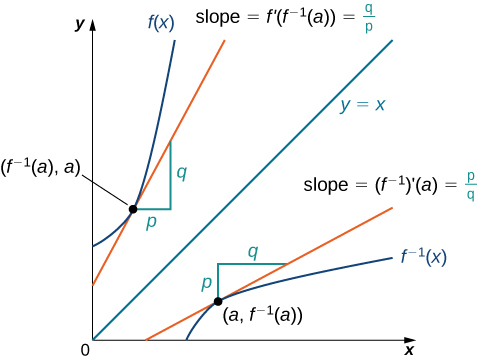
Figure 1. The tangent lines of a function and its inverse are related; so, too, are the derivatives of these functions.
We may also derive the formula for the derivative of the inverse by first recalling that [latex]x=f(f^{-1}(x))[/latex]. Then by differentiating both sides of this equation (using the chain rule on the right), we obtain
Solving for [latex](f^{-1})^{\prime}(x)[/latex], we obtain
We summarize this result in the following theorem.
Inverse Function Theorem
Let [latex]f(x)[/latex] be a function that is both invertible and differentiable. Let [latex]y=f^{-1}(x)[/latex] be the inverse of [latex]f(x)[/latex]. For all [latex]x[/latex] satisfying [latex]f^{\prime}(f^{-1}(x))\ne 0[/latex],
Alternatively, if [latex]y=g(x)[/latex] is the inverse of [latex]f(x)[/latex], then
Applying the Inverse Function Theorem
Use the Inverse Function Theorem to find the derivative of [latex]g(x)=\frac{x+2}{x}[/latex]. Compare the resulting derivative to that obtained by differentiating the function directly.
Use the inverse function theorem to find the derivative of [latex]g(x)=\frac{1}{x+2}.[/latex] Compare the result obtained by differentiating [latex]g(x)[/latex] directly.
Hint
Applying the Inverse Function Theorem
Use the inverse function theorem to find the derivative of [latex]g(x)=\sqrt[3]{x}[/latex].
Find the derivative of [latex]g(x)=\sqrt[5]{x}[/latex] by applying the inverse function theorem.
Hint
Use the fact that [latex]g(x)[/latex] is the inverse of [latex]f(x)=x^5[/latex].
From the previous example, we see that we can use the inverse function theorem to extend the power rule to exponents of the form [latex]\frac{1}{n}[/latex], where [latex]n[/latex] is a positive integer. This extension will ultimately allow us to differentiate [latex]x^q[/latex], where [latex]q[/latex] is any rational number.
Extending the Power Rule to Rational Exponents
The power rule may be extended to rational exponents. That is, if [latex]n[/latex] is a positive integer, then
Also, if [latex]n[/latex] is a positive integer and [latex]m[/latex] is an arbitrary integer, then
Proof
The function [latex]g(x)=x^{1/n}[/latex] is the inverse of the function [latex]f(x)=x^n[/latex]. Since [latex]g^{\prime}(x)=\frac{1}{f^{\prime}(g(x))}[/latex], begin by finding [latex]f^{\prime}(x)[/latex]. Thus,
Finally,
To differentiate [latex]x^{m/n}[/latex] we must rewrite it as [latex](x^{1/n})^m[/latex] and apply the chain rule. Thus,
Applying the Power Rule to a Rational Power
Find the equation of the line tangent to the graph of [latex]y=x^{2/3}[/latex] at [latex]x=8[/latex].
Find the derivative of [latex]s(t)=\sqrt{2t+1}[/latex].
Hint
Rewrite as [latex]s(t)=(2t+1)^{1/2}[/latex] and use the chain rule.
Derivatives of Inverse Trigonometric Functions
We now turn our attention to finding derivatives of inverse trigonometric functions. These derivatives will prove invaluable in the study of integration later in this text. The derivatives of inverse trigonometric functions are quite surprising in that their derivatives are actually algebraic functions. Previously, derivatives of algebraic functions have proven to be algebraic functions and derivatives of trigonometric functions have been shown to be trigonometric functions. Here, for the first time, we see that the derivative of a function need not be of the same type as the original function.
Derivative of the Inverse Sine Function
Use the inverse function theorem to find the derivative of [latex]g(x)=\sin^{-1} x[/latex].
Analysis
To see that [latex]\cos (\sin^{-1} x)=\sqrt{1-x^2}[/latex], consider the following argument. Set [latex]\sin^{-1} x=\theta[/latex]. In this case, [latex]\sin \theta =x[/latex] where [latex]-\frac{\pi}{2}\le \theta \le \frac{\pi}{2}[/latex]. We begin by considering the case where [latex]0<\theta <\frac{\pi}{2}[/latex]. Since [latex]\theta[/latex] is an acute angle, we may construct a right triangle having acute angle [latex]\theta[/latex], a hypotenuse of length 1, and the side opposite angle [latex]\theta[/latex] having length [latex]x[/latex]. From the Pythagorean theorem, the side adjacent to angle [latex]\theta[/latex] has length [latex]\sqrt{1-x^2}[/latex]. This triangle is shown in (Figure). Using the triangle, we see that [latex]\cos (\sin^{-1} x)= \cos \theta =\sqrt{1-x^2}[/latex].

Figure 2. Using a right triangle having acute angle [latex]\theta[/latex], a hypotenuse of length 1, and the side opposite angle [latex]\theta[/latex] having length [latex]x[/latex], we can see that [latex]\cos (\sin^{-1} x)= \cos \theta =\sqrt{1-x^2}[/latex].
Now if [latex]\theta =\frac{\pi}{2}[/latex] or [latex]\theta =-\frac{\pi}{2}, \, x=1[/latex] or [latex]x=-1[/latex], and since in either case [latex]\cos \theta =0[/latex] and [latex]\sqrt{1-x^2}=0[/latex], we have
Consequently, in all cases, [latex]\cos (\sin^{-1} x)=\sqrt{1-x^2}[/latex].
Applying the Chain Rule to the Inverse Sine Function
Apply the chain rule to the formula derived in (Figure) to find the derivative of [latex]h(x)=\sin^{-1} (g(x))[/latex] and use this result to find the derivative of [latex]h(x)=\sin^{-1}(2x^3)[/latex].
Use the inverse function theorem to find the derivative of [latex]g(x)=\tan^{-1} x[/latex].
Hint
The inverse of [latex]g(x)[/latex] is [latex]f(x)= \tan x[/latex]. Use (Figure) as a guide.
The derivatives of the remaining inverse trigonometric functions may also be found by using the inverse function theorem. These formulas are provided in the following theorem.
Derivatives of Inverse Trigonometric Functions
Applying Differentiation Formulas to an Inverse Tangent Function
Find the derivative of [latex]f(x)=\tan^{-1} (x^2)[/latex].
Applying Differentiation Formulas to an Inverse Sine Function
Find the derivative of [latex]h(x)=x^2 \sin^{-1} x[/latex].
Find the derivative of [latex]h(x)= \cos^{-1} (3x-1)[/latex].
Hint
Use (Figure). with [latex]g(x)=3x-1[/latex]
Applying the Inverse Tangent Function
The position of a particle at time [latex]t[/latex] is given by [latex]s(t)= \tan^{-1}(\frac{1}{t})[/latex] for [latex]t\ge \frac{1}{2}[/latex]. Find the velocity of the particle at time [latex]t=1[/latex].
Find the equation of the line tangent to the graph of [latex]f(x)= \sin^{-1} x[/latex] at [latex]x=0[/latex].
Hint
[latex]f^{\prime}(0)[/latex] gives the slope of the tangent line.
Key Concepts
- The inverse function theorem allows us to compute derivatives of inverse functions without using the limit definition of the derivative.
- We can use the inverse function theorem to develop differentiation formulas for the inverse trigonometric functions.
Key Equations
- Inverse function theorem
[latex](f^{-1})^{\prime}(x)=\frac{1}{f^{\prime}(f^{-1}(x))}[/latex] whenever [latex]f^{\prime}(f^{-1}(x))\ne 0[/latex] and [latex]f(x)[/latex] is differentiable. - Power rule with rational exponents
[latex]\frac{d}{dx}(x^{m/n})=\frac{m}{n}x^{(m/n)-1}[/latex]. - Derivative of inverse sine function
[latex]\frac{d}{dx}(\sin^{-1} x)=\frac{1}{\sqrt{1-x^2}}[/latex] - Derivative of inverse cosine function
[latex]\frac{d}{dx}(\cos^{-1} x)=\frac{-1}{\sqrt{1-x^2}}[/latex] - Derivative of inverse tangent function
[latex]\frac{d}{dx}(\tan^{-1} x)=\frac{1}{1+x^2}[/latex] - Derivative of inverse cotangent function
[latex]\frac{d}{dx}(\cot^{-1} x)=\frac{-1}{1+x^2}[/latex] - Derivative of inverse secant function
[latex]\frac{d}{dx}(\sec^{-1} x)=\frac{1}{|x|\sqrt{x^2-1}}[/latex] - Derivative of inverse cosecant function
[latex]\frac{d}{dx}(\csc^{-1} x)=\frac{-1}{|x|\sqrt{x^2-1}}[/latex]
For the following exercises, use the graph of [latex]y=f(x)[/latex] to
- sketch the graph of [latex]y=f^{-1}(x)[/latex], and
- use part a. to estimate [latex](f^{-1})^{\prime}(1)[/latex].




For the following exercises, use the functions [latex]y=f(x)[/latex] to find
- [latex]\frac{df}{dx}[/latex] at [latex]x=a[/latex] and
- [latex]x=f^{-1}(y)[/latex].
- Then use part b. to find [latex]\frac{df^{-1}}{dy}[/latex] at [latex]y=f(a)[/latex].
5. [latex]f(x)=6x-1, \, x=-2[/latex]
6. [latex]f(x)=2x^3-3, \, x=1[/latex]
7. [latex]f(x)=9-x^2, \, 0\le x\le 3, \, x=2[/latex]
8. [latex]f(x)= \sin x, \, x=0[/latex]
For each of the following functions, find [latex](f^{-1})^{\prime}(a)[/latex].
9. [latex]f(x)=x^2+3x+2, \, x\ge -1, \, a=2[/latex]
10. [latex]f(x)=x^3+2x+3, \, a=0[/latex]
11. [latex]f(x)=x+\sqrt{x}, \, a=2[/latex]
12. [latex]f(x)=x-\frac{2}{x}, \, x<0, \, a=1[/latex]
13. [latex]f(x)=x + \sin x, \, a=0[/latex]
14. [latex]f(x)= \tan x+3x^2, \, a=0[/latex]
For each of the given functions [latex]y=f(x)[/latex],
- find the slope of the tangent line to its inverse function [latex]f^{-1}[/latex] at the indicated point [latex]P[/latex], and
- find the equation of the tangent line to the graph of [latex]f^{-1}[/latex] at the indicated point.
15. [latex]f(x)=\frac{4}{1+x^2}, \, P(2,1)[/latex]
16. [latex]f(x)=\sqrt{x-4}, \, P(2,8)[/latex]
17. [latex]f(x)=(x^3+1)^4, \, P(16,1)[/latex]
18. [latex]f(x)=−x^3-x+2, \, P(-8,2)[/latex]
19. [latex]f(x)=x^5+3x^3-4x-8, \, P(-8,1)[/latex]
For the following exercises, find [latex]\frac{dy}{dx}[/latex] for the given function.
20. [latex]y= \sin^{-1}(x^2)[/latex]
21. [latex]y= \cos^{-1}(\sqrt{x})[/latex]
22. [latex]y= \sec^{-1}(\frac{1}{x})[/latex]
23. [latex]y=\sqrt{\csc^{-1} x}[/latex]
24. [latex]y=(1 + \tan^{-1} x)^3[/latex]
25. [latex]y= \cos^{-1}(2x) \cdot \sin^{-1}(2x)[/latex]
26. [latex]y=\frac{1}{\tan^{-1}(x)}[/latex]
27. [latex]y= \sec^{-1}(−x)[/latex]
28. [latex]y= \cot^{-1} \sqrt{4-x^2}[/latex]
29. [latex]y=x \cdot \csc^{-1} x[/latex]
For the following exercises, use the given values to find [latex](f^{-1})^{\prime}(a)[/latex].
30. [latex]f(\pi)=0, \, f^{\prime}(\pi)=-1, \, a=0[/latex]
31. [latex]f(6)=2, \, f^{\prime}(6)=\frac{1}{3}, \, a=2[/latex]
32. [latex]f(\frac{1}{3})=-8, \, f^{\prime}(\frac{1}{3})=2, \, a=-8[/latex]
33. [latex]f(\sqrt{3})=\frac{1}{2}, \, f^{\prime}(\sqrt{3})=\frac{2}{3}, \, a=\frac{1}{2}[/latex]
34. [latex]f(1)=-3, \, f^{\prime}(1)=10, \, a=-3[/latex]
35. [latex]f(1)=0, \, f^{\prime}(1)=-2, \, a=0[/latex]
36. [T] The position of a moving hockey puck after [latex]t[/latex] seconds is [latex]s(t)= \tan^{-1} t[/latex] where [latex]s[/latex] is in meters.
- Find the velocity of the hockey puck at any time [latex]t[/latex].
- Find the acceleration of the puck at any time [latex]t[/latex].
- Evaluate a. and b. for [latex]t=2,4[/latex], and 6 seconds.
- What conclusion can be drawn from the results in c.?
37. [T] A building that is 225 feet tall casts a shadow of various lengths [latex]x[/latex] as the day goes by. An angle of elevation [latex]\theta[/latex] is formed by lines from the top and bottom of the building to the tip of the shadow, as seen in the following figure. Find the rate of change of the angle of elevation [latex]\frac{d\theta}{dx}[/latex] when [latex]x=272[/latex] feet.
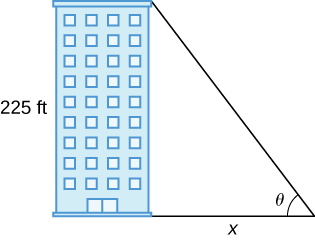
38. [T] A pole stands 75 feet tall. An angle [latex]\theta[/latex] is formed when wires of various lengths of [latex]x[/latex] feet are attached from the ground to the top of the pole, as shown in the following figure. Find the rate of change of the angle [latex]\frac{d\theta}{dx}[/latex] when a wire of length 90 feet is attached.
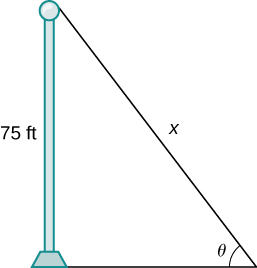
39. [T] A television camera at ground level is 2000 feet away from the launching pad of a space rocket that is set to take off vertically, as seen in the following figure. The angle of elevation of the camera can be found by [latex]\theta = \tan^{-1}(\frac{x}{2000})[/latex], where [latex]x[/latex] is the height of the rocket. Find the rate of change of the angle of elevation after launch when the camera and the rocket are 5000 feet apart.
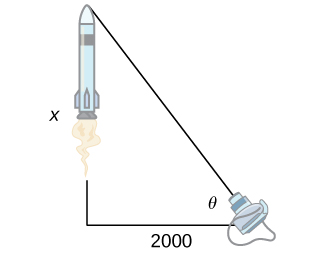
40. [T] A local movie theater with a 30-foot-high screen that is 10 feet above a person’s eye level when seated has a viewing angle [latex]\theta[/latex] (in radians) given by [latex]\theta = \cot^{-1}(\frac{x}{40})- \cot^{-1}(\frac{x}{10})[/latex],
where [latex]x[/latex] is the distance in feet away from the movie screen that the person is sitting, as shown in the following figure.
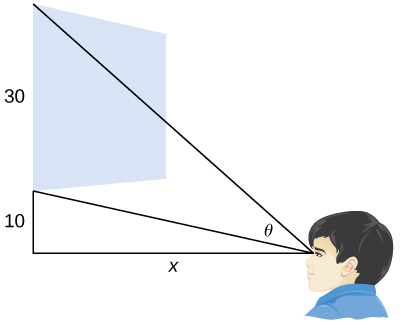
- Find [latex]\frac{d\theta}{dx}[/latex].
- Evaluate [latex]\frac{d\theta}{dx}[/latex] for [latex]x=5,10,15[/latex], and 20.
- Interpret the results in b.
- Evaluate [latex]\frac{d\theta}{dx}[/latex] for [latex]x=25,30,35[/latex], and 40
- Interpret the results in d. At what distance [latex]x[/latex] should the person sit to maximize his or her viewing angle?
Candela Citations
- Calculus I. Provided by: OpenStax. Located at: http://cnx.org/contents/8b89d172-2927-466f-8661-01abc7ccdba4@2.89. License: CC BY-NC-SA: Attribution-NonCommercial-ShareAlike. License Terms: Download for free at http://cnx.org/contents/8b89d172-2927-466f-8661-01abc7ccdba4@2.89



Use the preceding example as a guide.